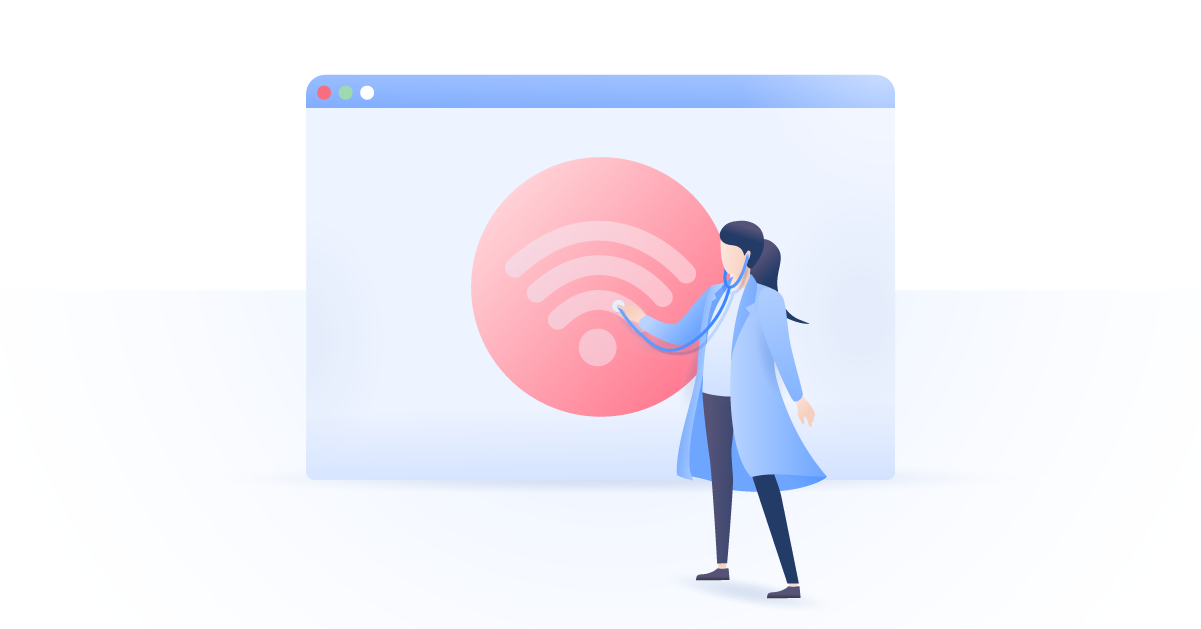Is my internet connection healthy?
Nothing is worse than bad internet. While you can ignore the warning lights on your car’s dashboard or pretend not to hear the squeaking of your kitchen door, internet issues make our blood boil. ISPs can throttle your bandwidth, block certain services, and sell your browsing data to marketers. How can you tell if they’re abusing your right to a free internet?

What is a healthy internet and how can you test it?
When you sign up for a 100-Mbps internet plan with your ISP, you probably don’t ask questions as long as it runs smoothly. However, there are a lot of things we don’t know about going on behind the scenes.
Here’s how your ISP can ruin your browsing experience:
- Network congestion (throttling the internet for all users during peak hours);
- Data caps (slowing down your speed when you hit your data cap);
- Paid prioritization (restricting access to certain services or throttling your bandwidth when you’re streaming).
You have healthy internet access when your ISP doesn’t limit your speed or control what you’re doing online. But it can be hard to tell if your internet connection is experiencing any throttling — unless you run the Internet Health Test.
What is the Internet Health Test?
The Internet Health Test is an online tool to measure various metrics and evaluate how healthy your internet connection is. This test can tell you if you’re getting less speed than you’re supposed to. As bandwidth throttling is a common practice, we recommend checking whether you’re getting everything you’re paying for.
How does the test work?
There are many different speed tests on the internet, and it doesn’t take more than a couple of clicks to run them. However, most of them can only show your internet speed, which doesn’t tell us anything.
In order to understand whether your ISP is throttling your connection, you need to compare it with other users. The Internet Health Test sends traffic to and from your device to a measurement point outside your ISP’s network. When many users run the test from different locations, it’s easy to spot differences in network performance. The test indicates how quickly you can connect to certain measurement points in particular locations.
Internet speed might vary throughout a day, so run your internet connection test multiple times to get the most accurate results. All the gathered data is sent to a database so that researchers can compare users’ experience in different locations.
Here’s how to test your connection speed:
- Go to http://internethealthtest.org/
- Click Go and wait for a couple of moments to see the results.
What is net neutrality?
Net neutrality is the idea that ISPs should allow users to access any content on the internet without favoring or blocking particular services. This is how the free internet should look like, but ISPs occasionally break these principles.
From 2007 to 2009, AT&T, an American telecommunications company, forced Apple to block Skype and other VoIP service providers on the iPhone. Their agreement was kept a secret, but with the growing pressure from users, AT&T had to back off.
Here’re a few types of services that occasionally fall under scrutiny and get blocked:
- P2P services
- Tethering applications
- Video streaming services
- Video calling apps
The more data the Internet Health Test gathers, the more detailed a picture of network congestion it gets. That will help it reveal dishonest ISPs by comparing results from different users and locations.
Where does the data go?
The Internet Health Test was developed by the Battle for the Net initiative, which aims to preserve net neutrality and prevent ISPs from bandwidth throttling. It uses M-Lab code and infrastructure to host all the collected data.
Why is the Internet Health Test important?
By taking the Internet Health Test, you contribute to a better internet. The more people take the test, the more likely it is that ISPs will be forced to change their policies.
In 2019, research by Northeastern University and the University of Massachusetts, Amherst, has revealed that US telecom companies were slowing internet traffic for YouTube and Netflix.
While wireless carriers say that online video usage is the cause of slow internet speed, the research proved that throttling was happening consistently. AT&T denied the allegations and said that they’re not restricting or throttling any services.
Speed tests and research can have a great impact on ISPs. If you’re suffering from bandwidth throttling or occasionally bump into restricted services, file a complaint with your ISP. Every voice matters.
How to avoid bandwidth throttling
Bandwidth throttling can ruin your browsing experience. Luckily, there is an easy way to bypass it — VPN software. It encrypts your traffic and masks your IP address, thus providing you with a digital invisibility cloak. When your VPN is turned on, an ISP can’t see what you’re doing online. They can see that you’re connected to the internet, but they can’t tell whether you’re watching Netflix or downloading files.
A VPN will also change your IP address. You might be located in the US, but instead appear as if you were in the UK, Canada, or any other country where your VPN service provider has servers. NordVPN offers more than 5,000 servers in 59 countries, giving you a wider range of choice.
With NordVPN, you can access blocked websites, avoid your ISP throttling based on your online activity, and access your favorite content securely. Even if your internet connection test proves that you have no issues with your speed, we recommend keeping a VPN on at all times, as it also enhances security. Don’t forget that ISPs can still throttle internet for everyone during peak hours.
You can test your internet connection speed here.
Here’s a further reading on why is your internet so slow if you need some additional guidance.
Don’t let your ISP win. Access a free internet with a VPN.